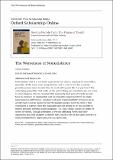The worseness of nonexistence
Abstract
Most believe that it is worse for a person to die than to continue to exist with a good life. At the same time, many believe that it is not worse for a merely possible person never to exist than to exist with a good life. I argue that if the underlying properties that make us the sort of thing we essentially are can come in small degrees, then to maintain this commonly held pair of beliefs we will have to embrace an implausible sort of evaluative hypersensitivity to slight nonevaluative differences. Avoidance of such hypersensitivity pressures us to accept that it can be worse for merely possible people never to exist. If this conclusion is correct, then the standard basis for giving no or less priority to merely possible persons would disappear (i.e., that things cannot be better or worse for them). Though defenders of Person-Affecting Views and their opponents may still disagree in theory, they could arrive at the same answers to many monumentally important practical questions.
Citation
Pummer , T G 2019 , The worseness of nonexistence . in E Gamlund & C T Solberg (eds) , Saving people from the harm of death . Population-level bioethics , Oxford University Press , New York , pp. 215-228 . https://doi.org/10.1093/oso/9780190921415.003.0016
Publication
Saving people from the harm of death
Type
Book item
Collections
Items in the St Andrews Research Repository are protected by copyright, with all rights reserved, unless otherwise indicated.

